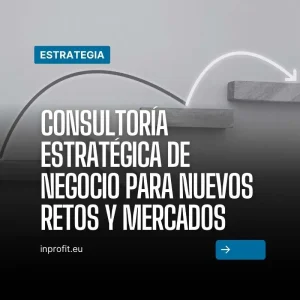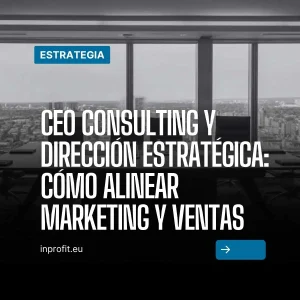
Discover how strategic business consulting helps you decide where to grow, how to enter new markets and which projects to prioritize to achieve real results.

Discover how strategic business consulting helps you decide where to grow, how to enter new markets and which projects to prioritize to achieve real results.

CEO consulting turns business strategy into an operational system: focus, narrative, pricing and RevOps aligned for frictionless growth. Shall we get started?

An SME doesn’t need “more actions”: it needs focus, measurement and pace of execution. This 12-week roadmap is designed to move you, with or without an external consultant, from single initiatives to a growth system with clear objectives, processes, and a metrics dashboard that “speaks the language of the business”:...

Imagine designing a campaign that not only communicates benefits, but connects directly with your audience’s desires, fears and biases. In a world where consumers are saturated with digital stimuli, understanding behavioral psychology has become the key differentiator between an indifferent campaign and one that actually drives conversions. The power of...

Discover how to conquer international markets from your screen with digital internationalization strategies. From globalized content to localized advertising and regulatory compliance, this post guides you to scale your brand globally with tools like Contentful and AWS.

The growth of a franchise or business chain is not just a matter of replicating a successful model in different geographical locations. Discover some secrets.

Design marketing strategies capable of resonating in a diverse international market, without losing the identity that makes them unique.

The design of commercial premises has evolved beyond the simple decoration of spaces.

To differentiate themselves, brands must focus on creating sensory experiences that connect emotionally with consumers. This is where strategic interior design and sensory marketing come into play, two powerful tools that, along with neuromarketing principles and thoughtful design, can transform a physical space into a place where customers not only...
As technology and marketing become increasingly intertwined, a key concept emerges: “Martech”. This contraction of ‘marketing’ and ‘technology’ encapsulates the integration of technological tools into marketing strategies to optimize and improve the efficiency and effectiveness of advertising campaigns. Below, we will explore how the convergence of marketing, technology, strategy and Martech is redefining the digital marketing landscape and how companies can leverage these elements to gain a competitive advantage.
Marketing, at its core, has always sought to connect with the customer in the most effective and efficient way possible. With the evolution of digital technology, marketing strategies have evolved to adopt a number of tools that facilitate this objective. From marketing automation platforms to advanced data analytics and artificial intelligence solutions, technology has enabled marketers to personalize the user experience and improve the accuracy of their campaigns.
Implementing technology without a clear strategy is like navigating without a map; you may eventually reach your destination, but the road will be littered with inefficiencies and missed opportunities. Effective Martech strategy involves not only selecting the right tools but also integrating them in a way that aligns with the company’s long-term objectives. This means understanding the customer journey, personalizing interactions and automating processes at strategic points to optimize both customer acquisition and retention.
The implementation of an innovation laboratory in marketing and new technologies is essential to foster a culture of creativity and adaptation in all areas of the company. This space allows experimenting with emerging tools, such as artificial intelligence, big data or augmented reality, to develop more effective and personalized marketing strategies. By integrating these solutions, organizations can anticipate customer needs, optimize internal processes and improve data-driven decision making. Such a lab not only boosts the marketing area, but also generates a transversal impact by providing departments such as sales, operations or human resources with innovative tools that increase their efficiency and competitiveness.
On the other hand, an innovation lab acts as a catalyst for interdepartmental collaboration, breaking down silos and promoting a change-oriented mindset. By involving all areas of the company, from finance to production, it encourages the co-creation of solutions that address specific challenges and take advantage of market opportunities. For example, the use of technologies such as predictive analytics can help finance forecast revenue trends, while virtual reality can optimize human resources training processes. This integration ensures that innovation is not limited to marketing, but becomes a strategic pillar that permeates the entire organization, aligning objectives and maximizing results.
Finally, the adoption of an innovation lab positions the company as a leader in its industry, attracting talent and strengthening its brand image. In a business environment where digital transformation is key, having a space dedicated to exploring new technologies and methodologies ensures a sustainable competitive advantage. It also enables the company to respond quickly to changes in the market, adapting products, services and marketing campaigns to consumer expectations. This proactive approach not only enhances the customer experience, but also drives economic growth and organizational resilience, ensuring that all areas of the company are prepared to meet the challenges of the future.
© 2025 Inprofit